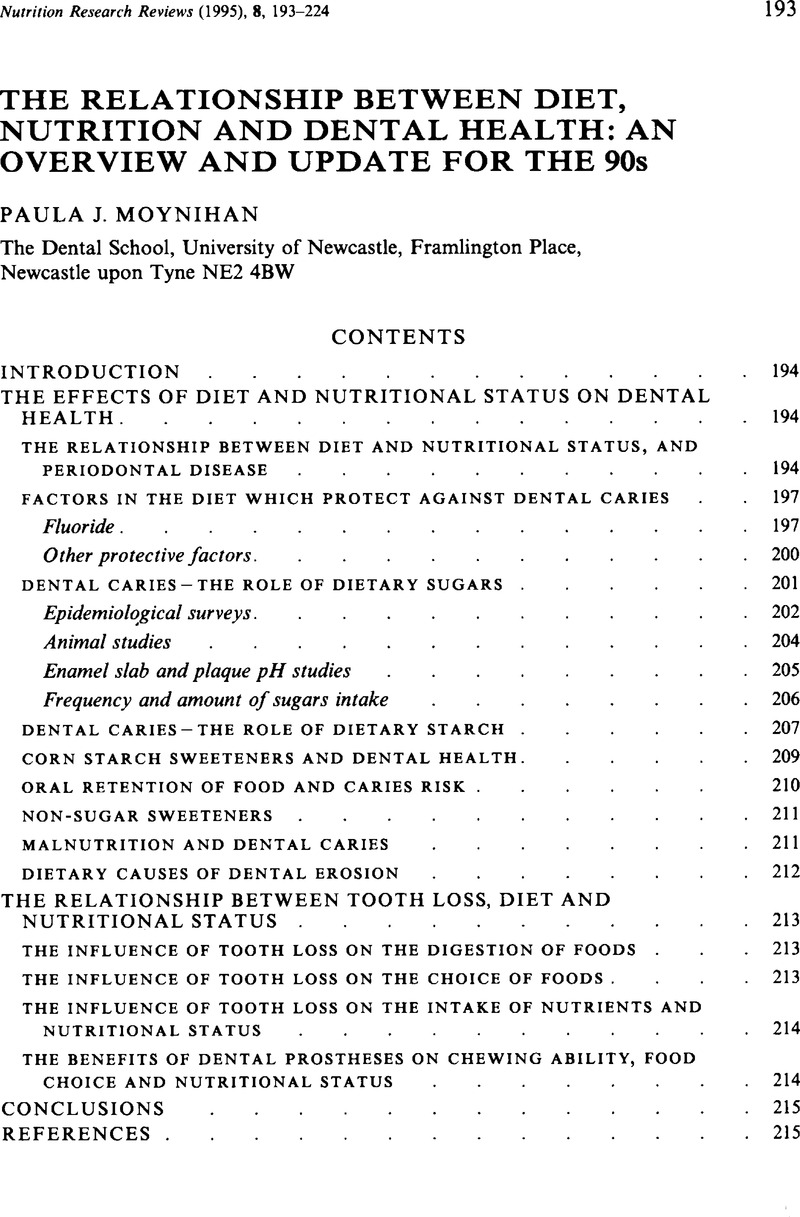Crossref Citations
This article has been cited by the following publications. This list is generated based on data provided by Crossref.
Pattison, Karen
Freeman, Ruth
Kuusela, Sisko
and
Honkala, Eino
1996.
Adolescent sugar choices in Belfast and Kuopio.
Journal of the Institute of Health Education,
Vol. 34,
Issue. 3,
p.
75.
Moynihan, P.J.
1998.
Update on the nomenclature of carbohydrates and their dental effects.
Journal of Dentistry,
Vol. 26,
Issue. 3,
p.
209.
Bunting, Grace
and
Freeman, Ruth
1999.
The influence of socio-demographic factors upon children's breaktime food consumption in North and West Belfast.
Health Education Journal,
Vol. 58,
Issue. 4,
p.
401.
Gibson, Sigrid A
2000.
Breakfast cereal consumption in young children: associations with non-milk extrinsic sugars and caries experience: further analysis of data from the UK National Diet and Nutrition Survey of children aged 1.5–4.5 years.
Public Health Nutrition,
Vol. 3,
Issue. 2,
p.
227.
Sheiham, A
and
Steele, J
2001.
Does the condition of the mouth and teeth affect the ability to eat certain foods, nutrient and dietary intake and nutritional status amongst older people?.
Public Health Nutrition,
Vol. 4,
Issue. 3,
p.
797.
Steele, James G
Sheiham, Aubrey
Marcenes, Wagner
Fay, Nick
and
Walls, Angus W G
2001.
Clinical and behavioural risk indicators for root caries in older people.
Gerodontology,
Vol. 18,
Issue. 2,
p.
95.
Sheiham, A.
Steele, J.G.
Marcenes, W.
Lowe, C.
Finch, S.
Bates, C.J.
Prentice, A.
and
Walls, A.W.G.
2001.
The Relationship among Dental Status, Nutrient Intake, and Nutritional Status in Older People.
Journal of Dental Research,
Vol. 80,
Issue. 2,
p.
408.
O'Neill, Maura
and
O'Donnell, Diarmuid
2002.
Smart Snacks Scheme: A healthy breaks initiative in the school environment.
International Journal of Health Promotion and Education,
Vol. 40,
Issue. 2,
p.
60.
Hackett, A F
Gibbon, M
and
Mercer, A
2003.
An evaluation of a healthy eating project for the promotion of dental health.
International Journal of Health Promotion and Education,
Vol. 41,
Issue. 3,
p.
84.
Marcenes, Wagner
Steele, Jimmy George
Sheiham, Aubrey
and
Walls, Angus Willian Gilmour
2003.
The relationship between dental status, food selection, nutrient intake, nutritional status, and body mass index in older people.
Cadernos de Saúde Pública,
Vol. 19,
Issue. 3,
p.
809.
Bailey, Regan L.
Harris Ledikwe, Jenny
Smiciklas-Wright, Helen
Mitchell, Diane C.
and
Jensen, Gordon L.
2004.
Persistent oral health problems associated with comorbidity and impaired diet quality in older adults.
Journal of the American Dietetic Association,
Vol. 104,
Issue. 8,
p.
1273.
Rugg-Gunn, AJ
Fletcher, ES
Matthews, JNS
Hackett, AF
Moynihan, PJ
Kelly, SAM
Adams, J
Mathers, JC
and
Adamson, AJ
2007.
Changes in consumption of sugars by English adolescents over 20 years.
Public Health Nutrition,
Vol. 10,
Issue. 4,
p.
354.
Du, MinQuan
Jiang, Han
Tai, BaoJun
Zhou, Yinghong
Wu, Bei
and
Bian, Zhuan
2009.
Root caries patterns and risk factors of middle‐aged and elderly people in China.
Community Dentistry and Oral Epidemiology,
Vol. 37,
Issue. 3,
p.
260.
Ma, R
Sun, M
Wang, S
Kang, Q
Huang, L
Li, T
and
Xia, W‐W
2013.
Effect of high‐fructose corn syrup on the acidogenicity, adherence and biofilm formation of Streptococcus mutans.
Australian Dental Journal,
Vol. 58,
Issue. 2,
p.
213.
Zaki, Nadine A. A.
Dowidar, Karin M. L.
and
Abdelaziz, Wafaa E. E.
2015.
Assessment of the Healthy Eating Index‐2005 as a predictor of early childhood caries.
International Journal of Paediatric Dentistry,
Vol. 25,
Issue. 6,
p.
436.
I, C. SUMATH
I, A. NANDHIN
and
PADMANABAN, JAYANTHA
2017.
Antagonistic activity of probiotic bacillus megaterium against streptococcus mutans.
International Journal of Pharma and Bio Science,
Vol. 8,
Issue. 1,
Fraser, Angela M.
2018.
Handbook of Famine, Starvation, and Nutrient Deprivation.
p.
1.
Percival, Tricia
Edwards, Julien
Barclay, Salvacion
Sa, Bidyadhar
and
Majumder, Md Anwarul Azim
2019.
Early Childhood Caries in 3 to 5 Year Old Children in Trinidad and Tobago.
Dentistry Journal,
Vol. 7,
Issue. 1,
p.
16.
Fraser, Angela M.
2019.
Handbook of Famine, Starvation, and Nutrient Deprivation.
p.
851.
Carvalho, Maria Rita G.
Pezo‐Lanfranco, Luis
and
Eggers, Sabine
2019.
‘One tooth one child’: evaluating the effects of diet and fertility on the oral health of women from archaeological sites in South America.
European Journal of Oral Sciences,
Vol. 127,
Issue. 1,
p.
52.



